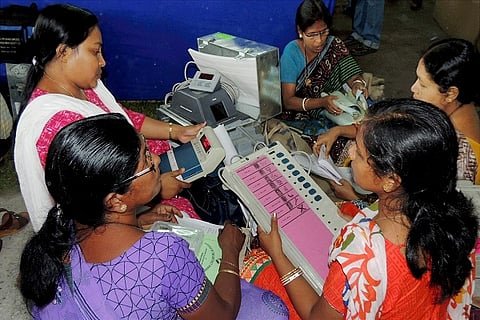

Come May 16, and the electorate in Kerala and Tamil Nadu will not only see the various political logos of the contesting parties on their Electronic Voting Machine (EVM), but also a new symbol- the ‘None of the above’ or the NOTA option.
The symbol, designed by the Ahmedabad National Institute of Design, will appear on the last panel on the EVMs.
NOTA was introduced as an option by the Supreme Court in October 2013, ahead of the assembly elections in Delhi, Rajasthan, Chattisgarh and Madhya Pradesh.
What does NOTA mean?
NOTA empowers a voter to register their ‘right to a negative opinion’ and reject the candidates participating in the election. While passing the ruling, the SC bench comprising of Chief Justice P Sadsivam and Justices Ranjana Desai and Ranjan Gogoi said that NOTA option would motivate political parties to nominate clean candidates. Further, not allowing a voter to exercise the NOTA option would defeat the purpose of freedom of expression and right to liberty, they said.
However, a high percentage of NOTA polled does not mean that the election will be invalidated; instead the highest polled candidate will be declared elected. NOTA only gives the voters the option to express their dissatisfaction with the candidates fielded from their constituency.
It was introduced with the intent to reduce the incidence of bogus voters, by encouraging voters to turn up for the elections, even if it is only to vote in favour of NOTA. Thus, the NOTA option will not really affect the result of the election, as NOTA votes would merely be counted as invalid votes.
Why not invalidate elections?
However, what is considered to be one major drawback with the NOTA is the inability of the option to invalidate the elections conducted. A petition addressing this issue was filed by Tharangambadi Duraisamy in the Madras High Court, in April.
In the petition, Duraisamy has requested the High Court to consider a re-election in the constituencies that record a NOTA count higher than the votes received by any other candidate. He also requested that the candidates who stood in the election be de-barred from subsequent elections for a stipulated period of time.
In response to his petition, a High Court bench headed by Judges M.Kirupakaran and MV Muralidharan said that the lawyer representing EC had reportedly objected to re-election being declared; and reinstated that the highest-polled candidate would come to power. However, the High Court has ordered a second hearing regarding the petition in July.
NOTA can still be a gamechanger
Nevertheless, the NOTA option has played game-changer in assembly elections time and again. In the 2014 Lok Sabha elections, Kannurconstituency in Kerala saw a NOTA vote count higher than the votes received by the runner-up CPI (M) candidate.
Neighbouring constituency Vadakera too saw a close fight between the candidates, with the Congress candidate winning the seat by a close margin. Vadakera registered a total of 6,107 NOTA votes; had the NOTA voters voted in favour of the CPI (M) candidate in Vadakera, he would have won.
Similarly, in the 2015 state assembly elections in Bihar, the NOTA vote count was higher than the victory margins in many constituencies. It has also been observed that more voters have taken to exercising the NOTA option, with polling percentage of the option increasing with every subsequent election.